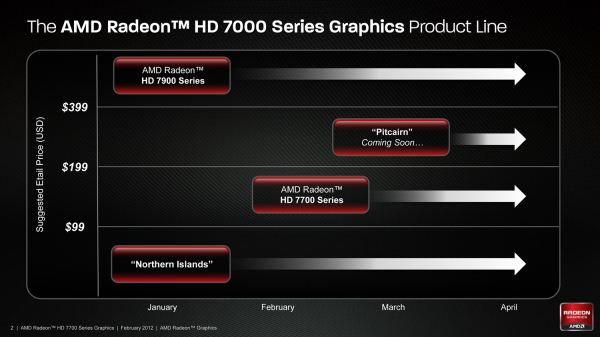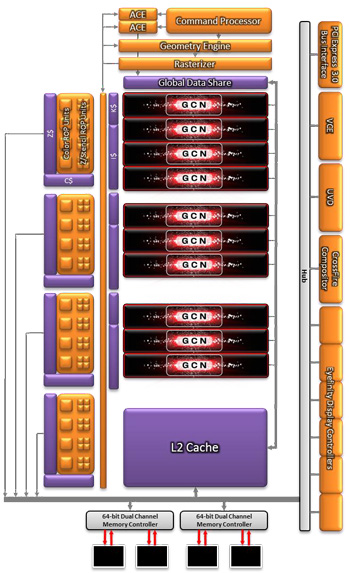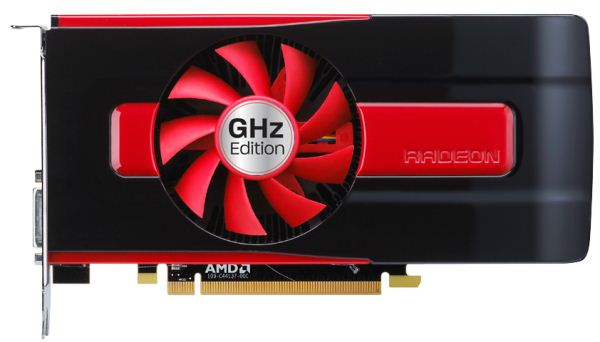AMD Radeon HD 7750 & Radeon HD 7770 GHz Edition Review: Evading The Price/Performance Curve
by Ryan Smith & Ganesh T S on February 15, 2012 12:01 AM EST- Posted in
- GPUs
- AMD
- HTPC
- GCN
- Radeon HD 7000
With the launch of Tahiti behind them, AMD is now firing on all cylinders to get the rest of their Southern Islands lineup out the door. Typically we’d see AMD launch their GPUs in descending order of performance, but this time AMD is taking a slight detour. Rather than following up the Tahiti based 7900 series with the Pitcairn based 7800 series, AMD is instead going straight to the bottom and launching the Cape Verde based 7700 series first.
Today AMD will be launching two cards based on the Cape Verde GPU: the Radeon HD 7750, and the Radeon HD 7770 GHz Edition. As the Juniper based 5700 series never got a proper Northern Islands successor, this is the first real update for the x700 series since the launch of the 5700 series in October of 2009. Given the success of the 5700 expectations are going to be high, and to fulfill those expectations AMD will be bringing to bear their new GCN architecture along with a full node jump with TSMC’s 28nm process. But will this be enough to enable the 7700 series to replicate the success of the 5700 series? Let’s find out.
| AMD GPU Specification Comparison | |||||||
| AMD Radeon HD 7770 GHz Edition | AMD Radeon HD 7750 | AMD Radeon HD 6850 | AMD Radeon HD 5770 | AMD Radeon HD 5750 | |||
| Stream Processors | 640 | 512 | 960 | 800 | 720 | ||
| Texture Units | 40 | 32 | 48 | 40 | 36 | ||
| ROPs | 16 | 16 | 32 | 16 | 16 | ||
| Core Clock | 1000MHz | 800MHz | 850MHz | 850MHz | 700MHz | ||
| Memory Clock | 4.5GHz GDDR5 | 4.5GHz GDDR5 | 4.8GHz GDDR5 | 4.8GHz GDDR5 | 4.6GHz GDDR5 | ||
| Memory Bus Width | 128-bit | 128-bit | 256-bit | 128-bit | 128-bit | ||
| Frame Buffer | 1GB | 1GB | 1GB | 1GB | 2GB | ||
| FP64 | 1/16 | 1/16 | N/A | N/A | N/A | ||
| Transistor Count | 1.5B | 1.5B | 1.7B | 1.04B | 1.04B | ||
| PowerTune Limit | 100W | 75W | N/A | N/A | N/A | ||
| Manufacturing Process | TSMC 28nm | TSMC 28nm | TSMC 40nm | TSMC 40nm | TSMC 40nm | ||
| Architecture | GCN | GCN | VLIW5 | VLIW5 | VLIW5 | ||
| Price Point | $159 | $109 | ~$149 | ~$99 | ~$89 | ||
With the 6000 series AMD effectively had a 5 chip stack: Caicos (6400), Turks (6600), the rebadged Juniper (6700), Barts (6800), and Cayman (6900). Since then integrated GPUs have effectively wiped out the low end of the market, and by the time Trinity launches later this year any product short of 6600 performance should be made redundant. As a result AMD has reigned in on their spread out stacks, leading to their 28nm Southern Islands product stack being just 3 products: Cape Verde (7700), Pitcairn (7800), and Tahiti (7900). Anything below the 7700 series will be rebadged Northern Islands parts, primarily Turks and Caicos.
But AMD’s product stack doesn’t tell the whole story. AMD will need to cover a wide range of products and price levels with only 3 GPUs, ranging from $109 to $550. As a result the performance levels of AMD’s various product series are being redefined somewhat, and nowhere is this more apparent right now than with the 7700 series. Why do we say that? Well let’s take a look at the specs and pricing.
Cape Verde, the GPU at the heart of the 7700 series, is AMD’s smallest 28nm GPU. With a die size of 123mm2 it’s only a hair bigger than the 118mm2 Turks GPU that powers the 6600 series. In terms of functional units we’re looking at 10 Compute Units, giving Cape Verde 640 SPs and 40 texture units. Elsewhere Cape Verde packs 16 ROPs, 1 geometry engine/rasterizer pair, and 512KB of L2 cache, with the chip coupled to a 128bit GDDR5 memory bus. Altogether compared to Tahiti this is around 31% of the CUs, 33% of the memory bus width, and half as many ROPs.
Interestingly, unlike Tahiti, Cape Verde’s CUs are organized slightly differently. GCN is designed around 4 CUs in each CU Array, with the 4 CUs sharing a read-only L1 instruction cache and a read-only L1 data cache. This is how both the 7970 and 7950 are organized, with the 7950 simply lopping off a whole CU array. However with Cape Verde 10 CUs doesn’t cleanly divide into groups of 4, so for the first time AMD has built something a bit different. In Cape Verde there are 3 CU arrays, populated in a 4/3/3 manner. With regards to performance there shouldn’t be a huge difference, but this does mean that there’s a bit less cache pressure on the CUs occupying the smaller CU arrays.
On the functionality side of things, backing up Cape Verde will be the rest of the Southern Islands family features we’ve already seen on Tahiti, such as DX10+ SSAA, PowerTune, Fast HDMI support, partially resident textures, D3D 11.1 support, and the still-AWOL Video Codec Engine (VCE). Even FP64 support is accounted for, however similar to how NVIDIA handles it on lower-end parts it’s a performance-limited implementation for compatibility and software development purposes, with FP64 performance limited to 1/16th FP32 performance.
As for the cards themselves, AMD will be releasing two Cape Verde cards: the Radeon HD 7750, and the Radeon HD 7770 GHz Edition. The 7770 will be a fully enabled Cape Verde with all 10 CUs (640 SPs) enabled, running at 1GHz for the core clock and 4.5GHz for the memory clock, with a PowerTune limit of 100W and an AMD defined typical board power of 80W. The 7750 meanwhile has 2 disabled CUs, giving it 512 SPs and 32 texture units, while the ROP count is unchanged at 16. The core clock will be 800MHz while the memory clock is the same as the 7770 at 4.5GHz, with a PowerTune limit of 75W and a typical board power of 55W. Both cards have a sub-10W idle TDP, while long-idle is sub-3W.
With those specs in mind, it’s interesting to note that the difference between the 7750 and 7770 is much wider than we’ve seen in past products. Compared to the 7750, the 7770 has 25% more CUs and a 25% core clock advantage, giving it a massive 56% shader and texture performance advantage over the 7750. With the 5700 series this gap was only 35%, and most of that was a result of core clock differences. The fact that the memory bandwidth is the same between the 7770 and 7750 equalizes things somewhat, but it’s still a huge difference for two cards that are in the same family.
This brings us back to where we started: how AMD is covering the entire $109+ market with only 3 GPUs. Between the massive performance gap between the 7700 series cards and the fact that the 7750 is a sub-75W part, it becomes increasingly obvious that the 7700 series is the de-facto replacement for both the 6600 series and the 5700 series. The 7750 will fill the 6670’s old role as AMD’s top sub-75W card, but as we’ll see its performance means it won’t be a complete replacement for the 5700 series. Instead the role of replacing the 5700 series falls to the much more powerful 7770.
As for today’s launch, AMD will be launching the 7750 at $109 and the 7770 at $159, which happens to be the same prices the 5770 and 5750 512MB launched at respectively. With midrange cards there usually aren’t any supply issues and we aren’t expecting the 7700 series launch to be any different, however as is customary AMD’s partners will be launching semi-custom cards from day one, so pricing will probably be inconsistent.
At these prices the 7700 series will be competing with a number of last-generation cards. The 7750 will be up against AMD’s 5770/6770 and the absolute cheapest of NVIDIA’s GTX 550 Ti cards. Meanwhile the 7770 will be competing with AMD’s 6850 and 6870, along with NVIDIA’s GTX 460 and their cheapest GTX 560s. And as we’ll see in our benchmarks, this is ultimately going to be more than the 7700 series can handle.
| Winter 2011/2012 GPU Pricing Comparison | |||||
| AMD | Price | NVIDIA | |||
| $209 | GeForce GTX 560 Ti | ||||
| $179 | GeForce GTX 560 | ||||
| Radeon HD 6870 | $169 | ||||
| Radeon HD 7770 | $159 | ||||
| Radeon HD 6850 | $139 | ||||
| $119 | GeForce GTX 550 Ti | ||||
| Radeon HD 7750 | $109 | ||||
| Radeon HD 6770 | $99 | ||||













155 Comments
View All Comments
Hellbinder - Thursday, February 16, 2012 - link
sorry for the type the 6000 list should have started with 6900Belard - Thursday, February 16, 2012 - link
This modern new 7750 at $110 performs about the same as a 4 year old 4850... which was selling for $100 about 3 years ago. The 4800 series was more expensive to produce and drink more power.The names don't mean much anymore, they were stupid to change the stack names which were fine from the 3000~5000 series.
delirious_nomad - Thursday, February 16, 2012 - link
there are reviews out there and 7770 X-Fired smoke a single 580 and for $300 some odd dollars...I have been out of PC gaming for along time and these are going to be my cards of choice.
reasons why... I don't care what the Jones do...
I play at 1080p on an adequate LCD TV... and I don't need graphics maxed to the gills...
I have older games Half Life, Jedi Knight, Knights of the Old Republic, Diablo, Morrowind, etc etc that I still want to play and the power down features and low power usage are great boons for me.
from the X-Fire reviews I've seen so far they scale at about 2x so just double the numbers and they smoke a single 580 while using less power and running nice and quiet...
also it gives me a year or so before I build my second system and who knows what will be out then. then this gets handed down to my son and off we go. and it should be plenty fast enough for Minecraft
the only card that comes really close for me is the 560 Ti 448 Core... and one of them is more expensive and doesn't beat a 580...
here is link to techpowerups' X-Fire review... http://www.techpowerup.com/reviews/HIS/HD_7750_777...
KineticHummus - Thursday, February 16, 2012 - link
"offers performance close to NVIDIA's GeForce GTX 570."That is straight from the techpowerup link you gave, on the conclusion page. Close to gtx 570 isnt smoking the 580 which is what you stated cf 7770s will do...
CeriseCogburn - Wednesday, March 21, 2012 - link
LOL - man ... thanks.Anyway there's a triple fan GTX 580 on egg for $359.
http://www.newegg.com/Product/Product.aspx?Item=N8...
---
I said it to you so I won't get attacked but maybe the gentleman would like to reconsider in light of our helpful posts.
papapapapapapapababy - Thursday, February 16, 2012 - link
this is all nice but sorry, I got burned waaaaaay to many times by AMD BS to even care! having to wait for months for proper support, faulty drivers and mind bogglingly piss poor performance per dollar in the latest games = never again going to buy or recommend any sort of AMD graphic solution. Im going to wait for the next gen consoles to launch, and then im going to get the absolutley cheapest and most efficient nvidia solution that offers me twice the performance of whatever m$, sony chooses to put inside their lil crappy casual boxes. Just like i Always DO, but his time AMD is out of the peculation for good! se ya.BoFox - Friday, February 17, 2012 - link
The only source of this is a slideshow from AMD regarding the launch of Barts GPUs.And then AMD launched Bulldozer with a slideshow saying that it has 2B trannies. A few months after launch, AMD admitted that it was an error, saying that it has only 1.2B trannies.
I've done such an extensive performance analysis to conclude that all Barts-based GPUs (6870, 6850, and 6790) are VLIW4-based just like its Cayman cousins.
GCN appears to be around 10% more efficient than VLIW4 for games overall, but it's very hard to say exactly how much. If a 78xx card that comes out next month has very similar specs to a VLIW4-based card (heck, or a VLIW5-based one), it'd be much easier to say. Still researching on this...
CeriseCogburn - Wednesday, March 21, 2012 - link
Man it's just amazing..." And then AMD launched Bulldozer with a slideshow saying that it has 2B trannies. A few months after launch, AMD admitted that it was an error, saying that it has only 1.2B trannies. "
I see that now...
" Update: AMD originally told us Bulldozer was a 2B transistor chip. It has since told us that the 8C Bulldozer is actually 1.2B transistors. The die size is still accurate at 315mm2. "
http://www.anandtech.com/show/4955/the-bulldozer-r...
Ok, there's just no way this core transistor miscount is a mistake. The level of incompetence requried for that to be a mistake and not a PR plot is staggering.
For that reason BoFox I don't doubt what you are saying about Barts 68xx's and 6790...
I'd sure love to see that exposed far and wide as well if true. It's just amazing to me, a staggering "error" on the most basic bulldozer spec... and we're supposed to just pretend it never happened and no explanation is ever given.
Yes there's a chance you are correct Bofox on your calculations, certainly cannot put it past amd given the track record.
maree - Friday, February 17, 2012 - link
From the consumer's point of view, the 7750 is the best card which doesn't require external power connector and hence can fit in with standard case and SMPS. The 7770 makes sense for those who crossfire, esp with long idle and compares favourably against the 6950/6970, esp for somebody who plans to buy only 1 7770 now and another one later when a better deal is availableFrom AMD's point of view, the 7750 seems to be targeted at the 80% of the Market who buy Intel PC, but are envious of the graphics capabilities of the puny Llano and even tinier Brazos. The 7770 seems to be targeted at the same folks for whom the BD was targeted. If somebody was prepared to buy a product(BD/7770) which is priced closer to competition(Core-i5/Gtx560) but gets beaten in all benchmarks and is priced more than old generation(PhenomII/6850) but still loses to it in many benchmarks. In short the 7770 is a Bulldozeresque disaster.
The situation would have been much better, if they had marketed these cards as 7670 and 7750, because that is were they belong based on die/transistor size and performance. Definitely a slip-up from AMD graphics Marketing dept.
Galidou - Sunday, February 19, 2012 - link
LoL rarson, let's not get into that kind of argument with chizow, you'll end up in WW2 history of tanks pricing failure due to the fact they were not double the raw power of last gen tanks from x company vs y company... history, history, history...Be careful with Chizow's arguments, he lives in the past, nothing new to reading his comments, it's already in the books and ready for anyone that reads it to perceive it the way they want(different from an ATI or Nvidia fanboy point of view)... :P